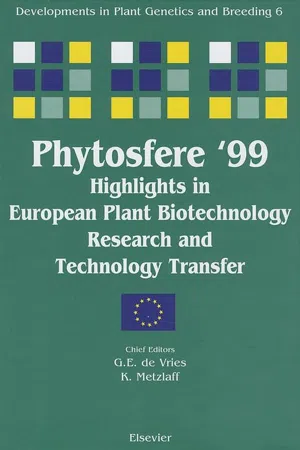
Phytosfere'99 - Highlights in European Plant Biotechnology Research and Technology Transfer
- 294 pages
- English
- ePUB (mobile friendly)
- Available on iOS & Android
Phytosfere'99 - Highlights in European Plant Biotechnology Research and Technology Transfer
About this book
Humans face the challenge of producing enough food to meet the demands imposed by economic, biological and agricultural factors: rising population; rising income; and an expectation of higher quality food and a more diverse diet; decreasing amount of land available for food production; lowering environmental impact of agricultural practices and preserving biodiversity.Biotechnology is one of the most exciting and dynamic industries of our day. It offers us the possibility of reducing our dependence on intensive farming. Plant biotechnology is central to the search for effective, environmentally safe and economically sound alternatives to the use of chemical pesticides and the exhaustion of natural resources. Today, applied plant science has four overall goals: increased crop yield, improved crop quality, reducing production costs and reducing negative environmental impact. Biotechnology is proving its value in meeting these goals. It offers farmers higher yielding crops with lower costs of production and new outlets such as nutraceuticals and crop-based bio-factories. It offers the European economy the potential of high quality, knowledge based job creation and the European consumer better quality, tastier and more nutritious food. Though there is public concern of genetic engineering, those who are close to the science understand that this is the next big frontier to be crossed. The potential and opportunities offered by plant biotechnology must not be missed. We must go forward on that basis rather than turning our backs on the science.Phytosfere'99 provides a comprehensive overview for plant biotechnology. It combines specific scientific articles, review articles and comments from outside people on it, which is unique in European Literature.
Frequently asked questions
- Essential is ideal for learners and professionals who enjoy exploring a wide range of subjects. Access the Essential Library with 800,000+ trusted titles and best-sellers across business, personal growth, and the humanities. Includes unlimited reading time and Standard Read Aloud voice.
- Complete: Perfect for advanced learners and researchers needing full, unrestricted access. Unlock 1.4M+ books across hundreds of subjects, including academic and specialized titles. The Complete Plan also includes advanced features like Premium Read Aloud and Research Assistant.
Please note we cannot support devices running on iOS 13 and Android 7 or earlier. Learn more about using the app.
Information
The Cluster: ”Responses To Challenges Of The Environment”

Concerted Efforts To Develop Handles For Plant Parasitic Nematode Control
2 Vakgroep Plantaardige Productie, Faculteit Landbouwkundige en Toegepaste Biologische Wetenschappen, Universiteit Gent, K.L. Ledeganckstraat 35, B-9000 Gent, Belgium
3 Laboratoire de Biologie des Invertébrés, Institut National de la Recherche Agronomique, B.P 2078, F-06606 Antibes, France
4 Istituto di Nematologia Agraria Applicata ai Vegetali, 1-70126 Bari, Italy
5 SCRI Nematology Department,DD2 5DA Invergowrie, Dundee, United Kingdom
6 Departamento de Biología, Universidad Autónoma de Madrid, Cantoblanco, E-28049 Madrid, Spain
Facultad de Ciencias del Medio Ambiente, Universidad de Castilla-La Mancha, E-45071 Toledo, Spain
7 Plant Insect Group, Department of Biological Sciences, University of Durham, DurhamDH1 3LE, United Kingdom
8 Institut für Phytopathologie, Christian-Albrechts- Universität, D-24118 Kiel, Germany
9 Plant Molecular Biology Group, Department of Biological Sciences, University of Durham, Durham DH1 3LE, United Kingdom
10 Zeneca MOGEN International N.V., NL-2333 CB Leiden, The Netherlands
11 IACR-Rothamsted, Entomology and Nematology Department, AL52JQ Harpenden, United Kingdom
12 Plant Breeding International Cambridge Ltd.Maris Lane, Trumpington, Cambridge CB2 2LQ, United Kingdom
13 Wageningen University, Laboratory of Nematology, Binnenhaven 10, 6709PD Wageningen, The Netherlands
Abstract

Introduction
Table of contents
- Cover image
- Title page
- Table of Contents
- Copyright page
- Preface
- Section I: Introduction
- Section II: Opportunities And Challenges Of European Plant Biotechnology
- Section III: Control Of Genes
- Section IV: Mapping Gene Location
- Section V: Controlling Development And Architecture
- Section VI: Response To Challenges Of The Environment
- Section VII: Uncovering Metabolic Pathways
- Section VIII: Entrepreneurship In Plant Science
- Author index